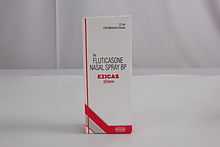Fluticasone propionate
 | |
|---|---|
| Systematic (IUPAC) name | |
| S-(fluoromethyl)-6α,9-difluoro-11β, 17-dihydroxy-16α-methyl-3-oxoandrosta-1, 4-diene-17β-carbothioate, 17-propanoate | |
| Clinical data | |
| AHFS/Drugs.com | monograph |
| Pregnancy cat. | C (US) C for Intranasal and Inhaled |
| Legal status | POM (UK) Rx Only (US) |
| Routes | Intranasal, Inhaled, Topical Cream or Ointment |
| Pharmacokinetic data | |
| Bioavailability | 0.51% (Intranasal) |
| Protein binding | 91% |
| Metabolism | Intranasal Hepatic (CYP3A4-mediated) |
| Half-life | 10 hours |
| Excretion | Renal |
| Identifiers | |
| CAS number | 80474-14-2 |
| ATC code | D07AC17 & D07AC04 (topical) |
| PubChem | CID 444036 |
| DrugBank | DB00588 |
| ChemSpider | 392059 |
| UNII | O2GMZ0LF5W |
| ChEBI | CHEBI:31441 |
| ChEMBL | CHEMBL1473 |
| Chemical data | |
| Formula | C25H31F3O5S |
| Mol. mass | 500.57 g/mol |
| SMILES
| |
| |
| | |

Fluticasone propionate is a corticosteroid derived from fluticasone used to treat asthma and allergic rhinitis. It is also used to treat eosinophilic esophagitis.
GlaxoSmithKline currently markets fluticasone propionate as Flovent (USA and Canada) and Flixotide (EU) for asthma, and as Flonase (USA and Canada), Flixonase (Australia, Brazil, EU, Morocco, India, Israel, South Africa, and South Korea) and Pirinase (UK) for allergic rhinitis (hay fever), as well as a combination of fluticasone and salmeterol as Advair (USA and Canada) or Seretide[1] (EU). In India it is also marketed by Intas under the trade name 'Ezicas'.
Flonase patent issues
(FDA) approved the sale of a generic version of Flonase on February 22, 2006. On February 23, 2006, GlaxoSmithKline (GSK) was able to obtain a temporary 10-day restraining order from a federal judge in Baltimore blocking the shipment and sales of the approved generic versions of Flonase. The restraining order lasted until March 6, 2006. The basis of the complaint by GSK was that the FDA failed to follow its own regulations in approving the generics and failed to apply the same quality standards for the generic version as it did for Flonase. GSK made these arguments in petitions filed with the FDA, but the FDA rejected those petitions. The Maryland District Court denied the request by GSK to extend the ban on Flonase generics beyond March 6, 2006, and GSK released a statement that they would not appeal the ruling.[2] The ruling meant that sales of generic versions of Flonase could proceed.
Monopoly class action lawsuit settlement
MEDICAL MUTUAL OF OHIO brought suit against GSK for conspiring to keep generic Flonase off the market. A class action lawsuit settlement with a “Total Settlement Amount” of $45 million was reached. Both consumers and insurance companies like the plaintiff had until August 15, 2013 to file a claim.[3]
Chemistry and Side effects
Fluticasone propionate is a synthetic trifluorinated glucocorticoid. It is highly lipophilic (logp octanol/water 3.69).[4]
In studies the topical drug has been associated with burning, stinging, skin irritation, blisters, dryness, skin infection, infected eczema, viral warts, impetigo, atopic dermatitis, pruritus, exacerbation of pruritus, exacerbation of eczema, erythema, and folliculitis.[5]
There are also numerous side effects associated with the oral version of this medication including headache, stuffy or runny nose, difficulty speaking, sore or irritated throat and painful white patches in the mouth or throat.[6]
Candidiasis of mouth and throat is reported as a "very common" side effect indicating that it occurs with a frequency greater than 1 in 10.[7] Hoarseness is "common" indicating a frequency from 1 in 10 to 1 in 100.[7] In both instances rinsing the mouth with water immediately after inhalation is recommended.[7]
Excessive use of corticosteroids, particularly fluticasone propionate, are "the most common cause of hypercortisolemia among all age groups." [8]
While hypercortisolism (excess cortisol) is common during fluticasone propionate inhaler use, hypocortisolism (suppressed cortisol) can be expected as a result of sudden withdrawal from fluticasone propionate.[9]
See also
- Fluticasone
- Fluticasone furoate
- Anti-inflammatory uses of glucocorticoids
References
- ↑ Allen & Hanburys. Package Leaflet: Information for the User of Seretide(tm) Evohaler(tm). GSK.
- ↑ Medical News Today
- ↑ https://flonasesettlement.com/LinkClick.aspx?fileticket=QIy2rAozjwo%3d&tabid=62&mid=420
- ↑ Drug Bank - Fluticasone Propionate
- ↑ FDA
- ↑ Fluticasone Oral Inhalation U.S. National Library of Medicine
- ↑ 7.0 7.1 7.2 Flixotide Inhaler Data Sheet, GlaxoSmithKline NZ Ltd, version 4.0, 26 March 2013
- ↑ Martignoni et al., 1992, The brain as a target for adrenocortical steroids: cognitive implications, Psychoneuroendocrinology, 17(4):343-354
- ↑ Swartz et al., 2012, Moderate Dose Inhaled Corticosteroid-Induced Symptomatic Adrenal Suppression: Case Report and Review of the Literature, Clinical Pediatrics, 51(12):1184-1190
| ||||||||||||||||||||||||||||
| ||||||||||||||||||||||||||||||||||||||||||||||||||||||
| ||||||||||||||||||||||||||||||||||||||